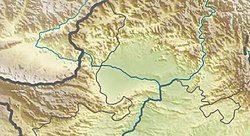Top Qs
Timeline
Chat
Perspective
Rukhuna reliquary
Buddhist reliquary From Wikipedia, the free encyclopedia
Remove ads
The Rukhuna reliquary, also sometimes Rukhana reliquary, also described as the Bajaur reliquary inscription, is a Scythian reliquary which was dedicated and inscribed in 16 CE by Rukhuna, Queen of Indo-Scythian king Vijayamitra (ruled 12 BCE - 20 CE). The inscription on the reliquary, also called the Bajaur reliquary inscription, was published by Richard Salomon with a photograph in 2005, and gives a relationship between several eras of the period, and especially a confirmation of a Yavana era (Yoṇaṇa vaṣaye) in relation to the Azes era, that is "Azes era= Yavana era - 128 years".[2][3]
Remove ads
Inscription
Summarize
Perspective
The inscription is very useful to clarify relative chronologies during the period. The inscription reads:
In Kharoshthi, the referential dates at the beginning of the inscription appear both in words and in numbers, together with the name of the era they are calculated in, and are given as follows:
vaṣaye sataviśaye 20 4 1 1 1 iśparasa Vijayamitrasa Apacarajasa aṇuśastiye ye vucati
"In the twenty-seventh - 27 - year in the reign of Lord Vijayamitra, the King of the Apraca"
ayasa vaṣaye tresa⟨*ta⟩timae 20 20 20 10 1 1 1
"in the seventy-third - 73 - year which is called "of Azes""
Yoṇaṇa vaṣaye ekaduśatimaye 2 100 1
"in the two hundred and first - 201 - year of the Yonas (Greeks)"
Śravaṇasa masasa divasaye aṭhamaye iśa divasaṃmi pratiṭ́havidu thuve Rukhuṇaye Apacarajabharyae Vijayamitreṇa Apracarajeṇa Iṃdravarmeṇa strategeṇa sabharyarehi sakumarehi"on the eighth day of the month of Sravana; on this day was established [this] stupa by Rukhuna, the wife of the King of Apraca, [and] by Vijayamitra, the king of Apraca, [and] by Indravarma (Indravasu?), the commander (stratega), [together] with their wives and sons."
This dedication also indicates that King Vijayamitra and his wife Rukhuna were followers of Buddhism.
Since Vijamitra is said to have ruled 27 years already, his reign started in 12 BCE, and ended probably a few years after the dedication took place, around 20 CE.
The authenticity of the inscription is nearly unanimously accepted by the academic community, Gérard Fussman being a dissenting voice.[10]
Remove ads
Similar examples of reliquaries
- Another similar example: the Bimaran casket. This reliquary is inscribed on the outside, rather than the inside.
- Broadly similar stone containers with compartments from Ai-Khanoum, 2nd century BCE.[11]
- Stone vessels (pyxides) from the Temple with niches, Sanctuary of Ai-Khanoum, 3rd-2nd century BCE.[11]
Remove ads
Notes
References
Wikiwand - on
Seamless Wikipedia browsing. On steroids.
Remove ads






